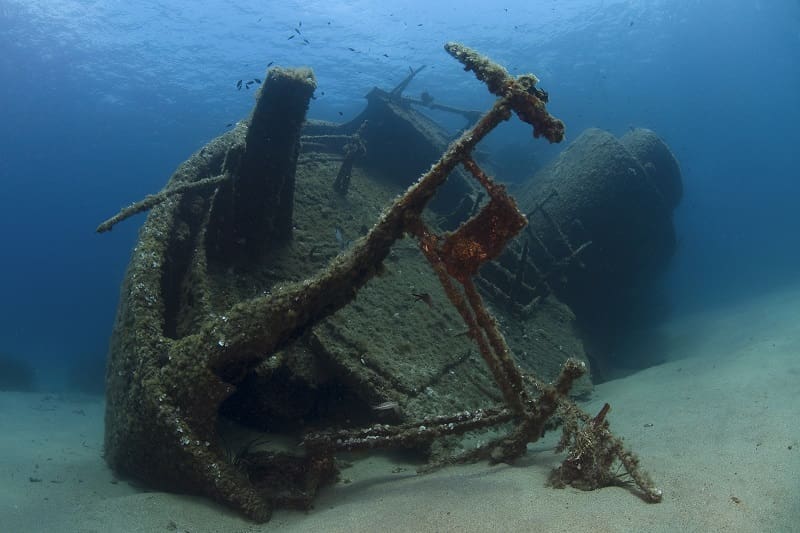Improve your underwater wreck photography
Wreck diving is a portal into history, whether diving on the skeletal remains of an ancient aircraft, or a colossal aircraft carrier that was sunk in the present day. Here are the ways that you can improve your photography in this niche speciality of scuba diving.
Establishing the First Image
Shooting wrecks successfully takes a combination of natural light and artificial light, so be sure to understand the visibility of the water that the wreck is in before taking the camera. If the visibility is good, usually in excess of 40 feet (10 metres) you can take fantastic images without use of artificial light. An initial establishing shot which is usually an image of the entire wreck, should establish the setting the photographer needs for the rest of the dive. In addition, try and capture the establishing shot before the other divers descend, or after the last diver of the group ascends. While adding a diver to the image can add perspective, it is good to have a human-free image. Furthermore when penetrating a wreck other divers’ bubbles can linger for hours, which can be frustrating.
Dangers of Wreck Photography
Many wrecks have unique aspects that are famous, for example either gun turrets, vehicles or even plates and cutlery. Much like your establishing shot, try and get these done first before you get the chance to explore the wreck further. However, when entering the confines of a wreck make sure that you have an understanding of the ocean conditions and the wreck itself. For example, many wrecks have large deposits of silt that can be kicked up by divers and cause disorientation. Furthermore jagged glass and metal, nets and tight portholes are all potentially dangerous to divers, and especially photographers who carry extra weight and size. Before descending on a wreck, make sure you understand the layout of that particular wreck as differing depths may cause difficulties with your dive planning.
Black & White or Colour?
While black and white images create an atmospheric and ethereal element to your images, adding colour can bring the image and the wreck to life. Many of the wrecks’ foundations attract colourful flora and fauna such as sponges, coral or shoaling fish. Many photographers’ favourite part of wreck photography is the interior/ exterior combination. Using strobes, you can focus on one or more items inside the wreck and then, in the background, incorporate a skylight or porthole that adds a dimension of exterior light. This creates the best image of a wreck, the sunken treasure and the ocean that surrounds it. Make sure to keep very still as silt can easily be kicked up and ruin the shot.
Sale Products
-
ScubaPro R095 Octopus
EAN: 4048336292993Original price was: $199.00.$150.00Current price is: $150.00. Add to cartSKU: 11.330.400
-
Atomic B2 Regulator & Z2 Octo Set With Amphos Air Wrist Computer (Rental Sales)
MSRP: $2,726.39You save 59%Original price was: $1,599.00.$1,095.00Current price is: $1,095.00. Add to cartSKU: RENTAL-REG- B2-1
-
Atomic B2 Regulator, Z2 Octo Set With Wisdom 3 Computer (Rental Sales)
MSRP: $1,919.39You save 48%Original price was: $1,395.00.$995.00Current price is: $995.00. Add to cartSKU: RENTAL-REG- B2
-
Atomic Z2 Reg/Octo With Oceanic VEO Computer (Rental Sales)
MSRP: $1,319.85You save 39%Original price was: $999.95.$799.00Current price is: $799.00. Add to cartSKU: RENTAL-REG-Z2
About The Author
Chris Vyvyan-Robinson
Born in London, England; Chris’ passion for photography and videography started from an early age. Over the last 20 years he has travelled to 5 of the 7 continents, including a year in South and Central America.
Chris’s passion is documenting the underwater environment and the creatures that inhabit that ecosystem. Over the past 4 years, while graduating from university with a degree in Film & Journalism, he has worked in Honduras, Indonesia and The Azores as a Divemaster & Guide.
Now an award winning filmmaker, Chris’ aspiration is to become a natural history cameraman.
Chris writes scuba diving articles for ScubaDiveMarketing.com who provide design, development and marketing to dive shops around the world.








